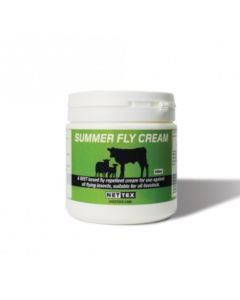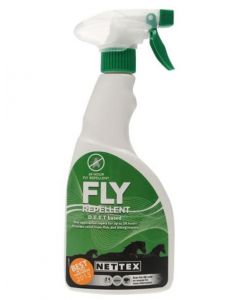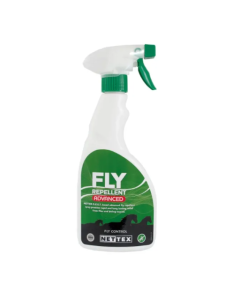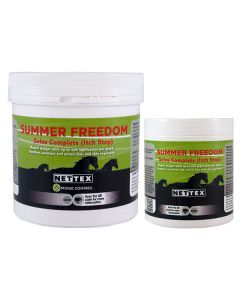When the sun starts to get hotter and our horses are spending more time in the heat, it is blissful to think the winter months have passed over. But, with the heat comes the all-dreaded flies. Trying to keep your horse and yourself away from any fly bites can be a challenge, so how can we keep the flys at bay and enjoy those sunny spring and summer days? Here are 10 top tips on how to protect your horse from flys.
1. Preparation is key
Start your fly protection tactics early to obtain the upper hand against flies and midges. Some flies can be seen as early as March, so being prepared ahead of time will help your horse or pony deal with these unwanted guests.
Before the midges start biting, set up suitable shelter, grazing, and husbandry routines, and make sure fly rugs and masks are worn. Acting before your horse or pony becomes itchy and irritated greatly reduces the impact of these bothersome parasites.
2. Protect exposed and sensitive areas
The face and ears are particularly sensitive to midge bites, therefore protecting these areas necessitates careful consideration and, in some cases, numerous means of protection. A physical barrier, such as a fly mask that covers the ears and part of the face, is excellent at keeping flies away from the eyes. As a repellent, topical remedies like Nettex Equine Summer Freedom can be applied to the exterior parts of the ears, face, and muzzle. Apply sparingly to sunburned parts of the muzzle.
Don't forget about the delicate skin surrounding the sheath, the tummy, and the delicate area behind the elbows. Regular use of a repellent such as Nettex Equine Fly Repellent Advanced or Nettex Equine Fly Repellent.
Read more: What to look for in good insect repellents
3. Do a patch test
Although the ingredients used in fly repellents are well tolerated by horses and ponies, a patch test is recommended before using any new product. This lowers the chances of your horse or pony developing a widespread allergic reaction to any product. To do a patch test, apply the product to a small area of skin and wait 48 hours before checking for any signs of a reaction.
4. Wash your horse or pony regularly
Sweat, urine, faeces – flies can’t help but be attracted to these aromas. Regular washing of your horse and pony to remove such attractants can help remove your horse from being a prime target for flies. Make sure to wash your horse after exercise, or on hot days, and wash off any stable stains thoroughly. Best in Test, Award-Winning, Nettex Equine Everyday Conditioning Shampoo is ideal for keeping your horse or pony clean and smelling fresh.
5. Feed a weatherproof garlic lick
Sweat, urine, and faeces — these smells are irresistible to flies. Washing your horse and pony on a regular basis to remove such attractants can help keep your horse from becoming a fly magnet. Take care to thoroughly wash your horse after exercise or on hot days, as well as any stable stains. Nettex Equine Everyday Conditioning Shampoo is a best-in-class, award-winning shampoo for keeping your horse or pony clean and smelling great.
6. Avoid grazing near rivers and streams
If possible, keep your horse away from rivers, streams, and damp, wet regions when grazing. Because flies and midges congregate around water sources, such areas have larger populations of flies and midges. Horseflies and midges both deposit their eggs in water and damp plants, making it a perfect breeding environment.
Removing your horse and pony from these locations can help limit their exposure to midges and flies significantly.
7. Aim for high ground, where possible
Flies prefer damp environments with little natural airflow, so creating the opposite climate for your horse will help keep unwanted pests at bay. High terrain is more exposed, has more breeze and movement, and is less likely to be near standing water - all of which makes it a less enticing setting for flies, making it ideal for your horse and pony to escape them. Because midges have little wings, they struggle to fly in gusts greater than 7 mph.
8. Take extra care at dusk and dawn
Midges bite at any time of day, however, swarms of adult midges are most active during dawn and dusk. Extra measures should be taken during these periods, such as wearing and properly securing fly rugs/masks, relocating horses and ponies from places near water, and applying repellents
9. Use a fly rug and mask
Fly rugs and masks can be highly helpful in regulating the comfort of horses and ponies that are particularly sensitive to fly and midge bites.
Applying creams or sprays under fly rugs and masks should be done with caution. Horses sweat under rugs and masks in hot weather, which might cause a response. Fly sprays can be used on the rug's outer surface to help keep flies and midges away. Rugs and masks, when properly fitted, create an efficient physical barrier against flies.
Choose a fly mat that is striped or spotted and brilliant white in colour to deter flies even more. Polarized light attracts flies, but such rugs reflect this light, making it less appealing to them.
Another thing to remember is to keep rugs and masks clean and clear of filth, urine, and faeces, as flies and midges are attracted to these scents. If this proves problematic, keep a backup fly rug and mask on hand to extend the time between washes and guarantee that your horse is never without a rug on laundry days.
Fly rugs should still be worn when your horse or pony is housed, as well as in the field because midges love to fly into stables (unlike horseflies, who don't enjoy shade).
10. Limit fly and midge access to stables
Although midges and some insects can follow your horse or pony into their stable, you can take efforts to minimise their entrance. To make the area less enticing to flies, keep stables clean and dry, removing urine and faeces on a regular basis.
Flys like regions where there is no natural ventilation, therefore providing sufficient airflow through barns and stables, or even a fan if your horse or pony tolerates it, will help prevent flying guests. Fly nets can be put on stable doors while your horse or pony is housed to minimise fly and midge access if your horse spends a lot of time out in the field socialising.
You can also control the fly population by utilising nature's defence system and natural predators. Although many people discourage Swallows and House Martins from nesting in stables, they consume fly eggs and larvae, so are quite handy to have around.















